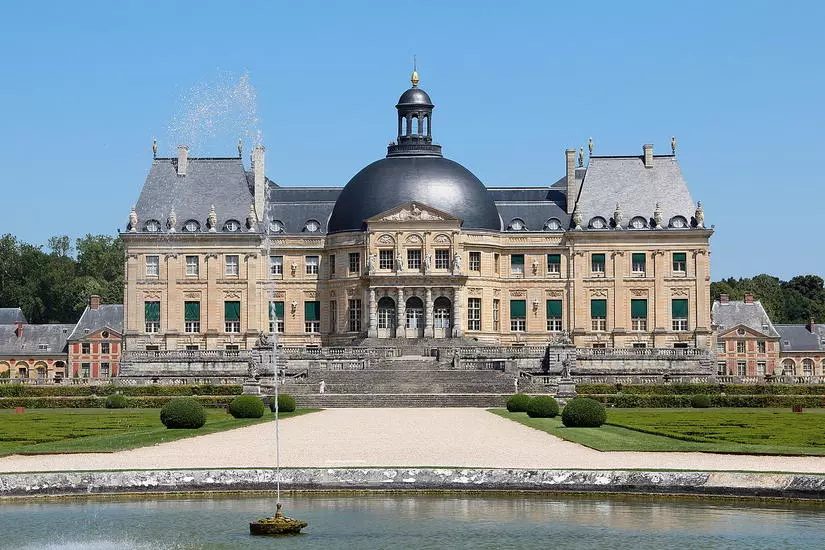10 Landmarks You Must See When Visiting France

Want to subscribe to a French energy offer?
Our English-speaking Selectra advisors are here to help you find the right energy plan.
(foreign IBANs accepted) at [email protected]. You can contact us also:

Sightseeing in a new country can actually be a bit stressful at times. Which landmarks and monuments are you going to see before you have to go back home? We’ve compiled this list of the 10 French landmarks you must see when you visit France.
Don't worry, this list of French landmarks doesn’t include the most obvious tourist spots like the Eiffel Tower. There are lots of sights to see in Paris and things to do in France that many people don’t know about! Here are our top picks:
Vaux-le-Vicomte
Anyone can go to the Palace of Versailles. But only true French history fans go see Vaux-le-Vicomte, the inspiration for Versailles. Yep, you read that right.
A young Parlement of Paris member named Nicolas Fouquet bought the land where Vicomte sits in 1641. Over the next several years, he -- along with a handful of architects -- reimagined and turned the land into a beautiful estate for himself, with sprawling gardens to match.
Fouquet threw a party there and invited King Louis XIV, who was in power at the time. The estate was meant to flatter the king, but instead, it just made him jealous. A few days later, the king ordered Fouquet’s arrest, and then ordered the architects who helped design Vicomte to create what we now know as the Palace of Versailles.
The story is also documented in the fictional world of “The Three Musketeers” by Alexandre Dumas.
How to get there: It’s about an hour by train from Paris Gare de l’Est. Once you arrive at "Verneuil l’Etang" station, you can wait for the château’s shuttle bus to pick you up and drive you to the estate.
Sacré-Coeur and Montmartre

If you’re looking for a different side of Paris, take a walk up through the Montmartre area and visit Sacré-Coeur Cathedral. The landmark boasts the best (free) view of the City of Light, thanks to its high elevation. The Cathedral itself is not as big as Notre Dame, but it’s just as beautiful with its decorated ceilings and vast interior.
The area of Montmartre holds a lot of history. Its winding roads and hilly neighbourhoods housed many well-known artists: Van Gogh, Matisse, Picasso, Degas, and Renoir are just a few. Nowadays, that artistic, bohemian vibe lives on, with musicians and vendors lighting up the streets with their art.
The name “Montmartre” means “Mount of the Martyr,” and was named after the Patron Saint of France and former Bishop of Paris, Saint-Denis. He was also, unfortunately, decapitated on the hill around 250 AD. But you won’t have to worry about that happening if you visit these days.
How to get there: Sacré-Coeur and Montmartre sit in the 18th arrondissement of Paris, in the northern part of the city. It is accessible primarily through metro lines 2 or 12. The metro stop “Abbesses” is the closest stop to the cathedral.
Saint-Malo
If you were looking to visit Mont St. Michel but were too put off by the crowds, try Saint-Malo instead. The two towns are built similarly, with their high, castle-like walls blocking out the rest of the world. But Saint-Malo is much bigger than Mont St. Michel, and you can easily feel more like a local thanks to the minimized tourist population.
Located on the Brittany coast in the northwestern region of France, Saint-Malo was founded by the Gauls in 1 B.C. The modern-day town can be traced back to a monkhood in the 6th century. During World War II, Saint-Malo was bombed heavily by the Allies, as they tried to free it from its German captors.
Nowadays, it’s a quaint seaside town that’s a perfect beach getaway for those living in the busy Paris city centre.
How to get there: Take the train from Gare Montparnasse in Paris. You can either take a direct train or transfer in the town of Rennes, depending on the train schedule. It’ll take roughly 3 hours to get there.
Giverny and Monet’s Garden

Even casual observers of art know who French Impressionist painter Claude Monet was, or have at least seen his infamous Water Lilies paintings.
Monet and his family settled in Giverny in 1883. When visiting the town, you’ll see the family's old farmhouse, their garden, and then, across the road, the Japanese water garden Monet installed ten years after he moved in. It would inspire him for the rest of his life.
How to get there: Take the train from Paris Gare Saint Lazare to Vernon-Giverny. It’ll take you about 45 minutes to get there. Then, you will need to take a bus or taxi to Giverny, as it is about 7 kilometres from the station.
Visiting France for a bit? Why not also learn about French culture and French food in our dedicated guides to get the most our of your experience!
Père Lachaise
“A cemetery?” you may ask. “Why waste my time going there?” Because this is not any old cemetery, my friend. Not only is Père Lachaise beautifully organized and surrounded by tall, castle-like walls; it also contains many famous names.
Are you a fan of Oscar Wilde? What about Frédéric Chopin, or Jim Morrison? These three have been laid to rest here, along with many others of different nationalities.
Napoleon established the cemetery in 1804, declaring every citizen, regardless of race or religion, had the right to be buried. Today, it is the largest cemetery in Paris, filling up 440,000 square meters of land.
How to get there: Take Paris metro line 2 and get off at either Père Lachaise or Philippe Auguste station.
Sainte Chapelle
This is definitely one of the top sights in Paris, at least in our eyes. Get ready to be surrounded by the most beautiful stained glass windows you’ll probably ever see in your life. Stunning doesn’t even come close to explaining it.
Completed in 1248, the chapel sits on the Île de la Cité in Paris and is a testament to the Gothic style that ruled France for a couple of centuries. It houses 15 stained glass windows that dictate 1,113 scenes from the Old and New Testament of the Bible. It was originally built to house Christian relics, including Christ’s crown of thorns.
How to get there: Take Paris metro line 4 and get off at the stop called “Cité.”
Verdon Gorge

If you’re an adventure-junkie, you’ve got to visit what’s affectionately nicknamed the “French Grand Canyon.” You can find it in the southeastern Provence region of France, in the Regional Park of Verdon. The gorge is 700 meters deep at some points, and at 25 kilometres long, it’s one of the largest gorges in Europe.
It’s a popular spot for kayaking and whitewater rafting. But if you’re into a different kind of adventure, the park’s got you covered: aerial sports like paragliding are also available!
How to get there: If you want to take the train from Paris, it’ll take about six hours. Alternatively, you could fly from Paris to Marseille or Nice and take either a bus or train from there. However, this will likely run you up into the 7 or 8-hour travel range.
Palais Garnier
Designed under the reign of Napoleon III by architect Charles Garnier, this ornately decorated building is impossible to miss when visiting Paris. It was finished in 1875 and was the primary theatre in Paris for the ballet and opera until the opening of the Opéra Bastille in 1989.

It’s been referenced a fair amount in pop culture, most notably in the 1910 novel, “The Phantom of the Opera,” which would later become the beloved musical we know today.
If you’d like to take a peek inside, you don’t necessarily need to buy tickets to the ballet; guided and self-guided tours are available daily.
Don’t miss out on the gold-lined ceilings and a grand staircase that’ll rival even the most extravagant palaces.
How to get there: Take Paris metro line 3, 7 or 8 to “Opéra,” line 9 or 7 to “Chaussée d'Antin La Fayette,” or the RER A line to “Auber” station to see this beauty in person.
Fontenay Abbey
Take a trip to the little town of Marmagne, in the Centre-Val de Loire region, to pay this landmark a visit. This Roman-style abbey was originally built in 1118, and it’s still standing tall!
It’s a great place to immerse yourself in what religious life was like 900 years ago: you can wander through the old meal hall, the dormitories, and take Harry Potter-esque photos in the cloister, or covered walkway.
How to get there: Take the train from Paris to Montbard; it’ll take a little over an hour. You can then take a taxi from Montbard to the Abbey, not too far away.
The Louvre

As one of the most famous landmarks in France, we couldn’t leave it off the list even if we wanted to.
This museum is more than just the home of the Mona Lisa. It’s a beautiful former palace, built in the late 12th to 13th century under King Philip II. It housed several different reigning kings until Louis XIV moved to Versailles and used the palace as a place to display the royal collection.
It was only during the French Revolution that it was decided that the palace would be turned into a museum that would display France’s treasures.
So pay a visit to Mona, but don’t forget to look at all the other 35,000 works (roughly) that are on display at any given time!
How to get there: Take Paris metro line 1 to metro stop “Louvre-Rivoli” or “Palais Royal - Musée du Louvre.” Metro line 7 will also take you to the latter stop.